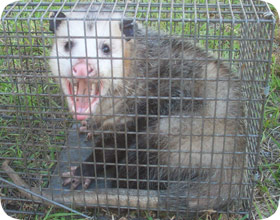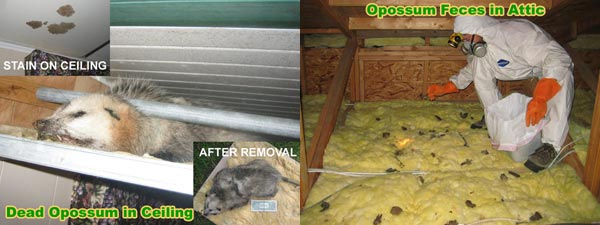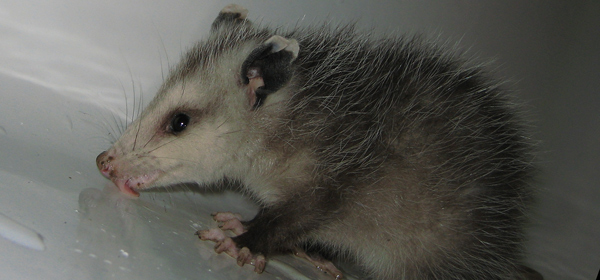- info@wildlife-removal.com
Call us for help in your town
Wildlife Removal Education
Opossum Removal and Control
Need opossum removal in your hometown? We service over 500 USA locations! Click here to hire us in your town and check prices - updated for year 2021.
 Opossums are usually classified as a pest species due to their habits of scavenging and living in attics and under houses. The most common complaints include the following:
Opossums are usually classified as a pest species due to their habits of scavenging and living in attics and under houses. The most common complaints include the following:
- Opossums living in the attic
- Opossums living under deck or house
- Dead opossum on property or roadside
- Stealing pet food or bird seed
- Sick, potentially dangerous opossum
- Presence is alarming dogs/pets
HOW DO I GET RID OF OPOSSUMS?
The best way is physical trapping and removal. The good news is that opossums are relatively easy to catch. They're not very bright (I once read that they've got the lowest brain mass to body mass ratio of any mammal) and
they scavenge for food, so they're easily caught. However, as usual, trapping carries many intangibles. If you've got an opossum under your shed, will you catch the target animal, or a stray cat? Will you be able to
legally relocate the animal? Will you take the proper safety precautions? Is it legal for you to do so in your state? Etc. I have written a full guide to possum trapping if
you want more information. I do, for safety and legal reasons, and because wildlife control is a specialty, and complex field, recommend that you hire a professional wildlife control operator to help you with your
opossum issue. You don't want a regular pest control company, but rather a specialist who works with wild animal removal. My directory, which I compiled, is a great resource.

Since it's a common problem, I have here an advice article with photos on opossums in the attic.
OPOSSUM BIOLOGY:
(Didelphis virginiana) Possums look somewhat like giant rats, with their pointed snouts and skinny, naked tails. They are in fact North America's only marsupial (like kangaroos, they raise their young in a pouch).
Adults average 10-14 lbs. They don't live very long, rarely more than two years, three max. They mate in January, and then the tiny young climb into the pouch and grow, then
cling to the mother's back, then drop off and lead a life on their own. Opossums are omnivores, which means that they eat anything. They are nocturnal. They have the most teeth of any mammal (50), a prehensile tail,
opposable thumbs, the male has a bifurcated penis, and they have incredible immune systems. Read more About Opossum Tails.
OPOSSUM BEHAVIOR: Possums are nomadic and opportunistic animals. They sometimes establish a home base, especially a female with young, and often live in human structures. They rummage around at night for food, and
will eat pretty much anything, but prefer meat, and even rotting carcasses. They are not very fast, and will stand their ground when threatened, bearing their 50 sharp teeth. In dire circumstances, they will sometimes
feign death, or "play possum" - they fall over, tongue hanging out, etc. It may be more an act of passing out from sheet terror as opposed to a grand act. Opossums can, if they wish, hang from their tails, but they
very rarely do this. I show how to grab one by the tail in my how to catch a possum guide.
NUISANCE CONCERNS:
Because they are opportunistic scavengers, they can come into conflict with people and cause various problems. They'll steal garbage, pet food, etc. They can distress pets, and if a dog corners one, it can get a nasty bite. They can spread
fleas and other parasites. Most of all, they often like to live in human structures, such as under sheds or decks, and they very commonly live inside of attics. When an opossum lives in an attic, it makes the attic
its personal toilet, and leave a lot of droppings. Click here for photos of possum poop. They can also cause destruction in houses and attics. In addition, possums
very frequently die inside buildings, inside the attic or walls, and the smell of a rotting opossum body is horrible. Click here for more photos of types of possum damage.

OPOSSUM DISEASES: Opossums actually don't often carry rabies. They have a lower than average body temperature, and the virus doesn't survive well. They do carry a large amount of parasites, however, and thus
are vectors for the diseases that fleas, ticks, etc can transmit. They also leave a lot of droppings, which pose the usual excrement health risks, such as leptospirosis or Salmonella. Read the guide What Diseases Can Opossums Carry?
OPOSSUM HABITATS: Possums are very common in urban areas, more common, in fact, than in wild areas. They are often nomadic, so sometimes they'll just wander about from place to place.
But they do oftentimes choose to live in one place for a long time, and they especially seem to like man-made structures. I often find possums in the house, and
as stated, I very commonly find them in attics. They seem to really like living in the walls of homes, and they often live under houses, where they can climb
up the walls or the hole under the bathtub outlet. I've also seen possum in the basement. They love sheds, decks, or any small area they can climb under. They
frequently get under mobile homes or trailer homes. -
CAN'T I JUST USE A REPELLENT?
There is no registered or effective opossum repellent available. You can find some products on the market, such as mothball-based or urine-based repellents, but they are bogus. Go ahead and try them. And those high-pitch
noisemakers? The FTC has issued a warning against them - ultrasonic sound emitters do not work. There is no quick and easy fix when it comes to opossum control. It's best to have a professional trap and remove the
animals properly. Here is my full analysis of possum repellent.

Click here for a nationwide list of 100's of professional opossum trappers serving all 50 states.
Phoenix Opossum Control -
Los Angeles Opossum Control -
San Diego Opossum Control -
San Jose Opossum Control -
Denver Opossum Control -
Orlando Opossum Control -
Miami Opossum Control -
Jacksonville Opossum Control -
Atlanta Opossum Control -
Chicago Opossum Control -
Baltimore Opossum Control -
Boston Opossum Control -
Minneapolis Opossum Control -
Charlotte Opossum Control -
Portland Opossum Control -
Philadelphia Opossum Control -
Houston Opossum Control -
Seattle Opossum Control
CAN I KILL THE OPOSSUM WITH POISON?
No, please don't try. If you use rat poison, it probably won't kill the animal. Any type of poison might harm a non-target animal such as a pet dog or cat. There are no known, registered poisons to kill opossums.
You can read more about possum poison here.
Opossum Email From Reader: There's a large possum who's been getting into my garbage for about a month now. She's actually quite good at problem solving.
I'm impressed. I saw her tonight and chased her off. I think she lives under my neighbors deck. What would be the cost to trap her and have her removed? You don't kill
the animals when you trap the do you? I do not want to see the animal destroyed. Thanks, Mark
My Response: Please check my directory, and you can find a good wildlife operator in your area. I don't know the cost, companies charge differently. You could also try securing your garbage can lids with bungee cords.
Opossum Email From Reader: I'm sure you get these kind of questions all the time, but I must ask. Okay, we feed neighborhood cats and food is left outside. I picked up the cat bowl one day and noticed it was very moist.
I also saw tracks, which through a field manual I identified as an opossum. I touched this cat bowl, which obviously had saliva on it, and then I rubbed my eyes. I didn't think about it until afterwards, but what is the
possibility that I could have rabies? I am seriously freaking out over this! Should I get rabies shots just in case? What about my dog? She licked my face and my mouth. Can she have rabies? She isn't vaccinated. I am so
worried! Please respond ASAP!
My Response: I personally wouldn't worry at all, rabies is extremely rare, and opossums don't get rabies, because they have a lower than average body temperature. Opossums have never transmitted rabies to people,
and I don't think it could be transmitted that way - the virus has to stay warm to live. Most dogs should be vaccinated though, on principle.
That is good to hear. Thanks. I have had a fever the last few days. Should I be worried? Could this be a sign of rabies? I'm kind of a
hypochondriac..sorry. lol My dog can't have the rabies vaccine because she is allergic, but she is an inside dog.
All About Opossums
Need opossum removal in your hometown? We service over 500 USA locations! Click here to hire us in your town and check prices - updated for year 2021.
The opossum is also popularly called "possum". It is one of the oldest mammals that has survived on earth, earning it the name ‘living fossil’. More than 60 different species exist but the common one is the Virginia opossum, or simply common opossum, and it is the only pouched mammal (marsupial) to be found in the United States and Canada.

Physical Appearance
The opossum has a pointed face and large ears. An adult opossum is about the same size as a house cat, but has much shorter legs. The fur is generally gray but sometimes can vary from white to brown to black. The opossum has a narrow, tapered snout, whose jaws contain fifty fairly large, pointed teeth. Also distinctive, is a long, naked, prehensile tails, which is adapted for grasping items and for maintaining stability while they are in a tree. Facial features include hairless ears and a long, flat snout and pink nose. Opossums have opposable, clawless thumbs on their rear limbs. Read the guide How Big Can Opossums Get?
Diet
The opossum is omnivorous, living off both animal and plant material. It is an opportunistic feeder and will eat just about anything that is available in its environment. Its widely varied diet includes insects, to earthworms, slugs, snails, crayfish, snakes and lizards, frogs, small rodents, small birds, eggs, grasses, vegetables, fruits, berries, grains, and even dead animal material. The opossum is also a scavenger, raiding garbage cans in homes and settlements.
The opossum’s diet tends to change with the seasons. It actively forages for food at night, prowling about with its nose to the ground and relying primarily on its senses of smell and touch. It is also an expert tree climber, searching for young birds and eggs. The opossum keeps itself stable on trees with its tail and dexterous hind feet.
Habitat
Opossums are often found in urban and suburban areas, they more naturally live in wooded areas that have water running through. They seek shelter in the abandoned dens and nests of skunks, foxes, and other animals. Opossums also live in sheds or old buildings, cavities in rocks, tree holes, brush piles, and fallen logs. They usually line their dens with nesting material gathered and collected with their reprehensible tail. These materials include dried twigs, leaves, and grass. Read the guides What is the habitat of the opossum? and What Should You Do If You Find A Nest of Baby Opossums?
Behavior
Opossums are primarily nocturnal animals, hunting for food after dusk. They however sometimes increase their daytime activity to forage food, especially during winter months when the food availability is unable to keep up with its increased metabolic needs. They change dens and nests quite often, except in cases where a productive food source is nearby. Female opossums with young also retain their dens for several weeks at a stretch.
A notable behavior for which opossums are known, is that of feigning death when faced with a threat or attacker. The term, ‘play possom’ was coined from this passive defensive tactic of the opossum. It flops onto its side and lies on the ground with eyes closed or staring fixedly into space. It even hangs its tongue out and drools for effect. This ploy may put a predator off its guard and allow the opossum an opportunity to make its escape. In this state, the opossum can withstand considerable abuse without flinching. And it will remain in this catatonic state for several minutes or even hours, depending on the situation.
Another defensive behavior of the opossum’s when cornered, is to bluff by baring its formidable set of 50 teeth while growling in a crouched position. It intimidates many animal and human would-be predators in this manner, despite its small size.
Reproduction/Life Cycle
Female opossums give birth one to three times in a year and the size of their litter varies from 7 to 9 young. At the time of birth, which is roughly 2 weeks after mating, the babies are underdeveloped and just about the size of a bumblebee. Their forelimbs are however well formed with claws, and they crawl from the birth opening into the mother’s pouch, where development continues for them. The pouch houses 13 tiny teats from which they get nourishment as they grow. Read
Young opossums leave the pouch when they are two to three months old but continue to nurse in their mother’s pouch for another month or two. At this stage, they latch onto the mother's back as she forages and start learning to eat solid foods. Afterwards, they get weaned and become independent. Read the guide Opossum Mating Habits.
Go back to the Opossum Removal page.


















